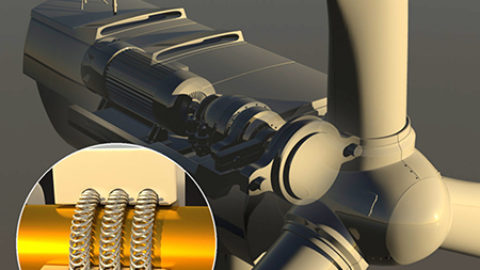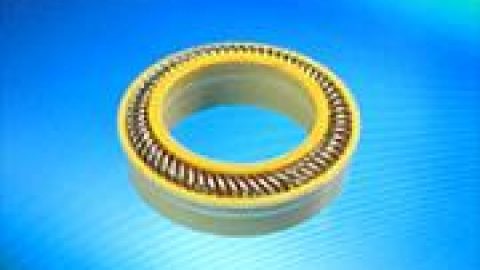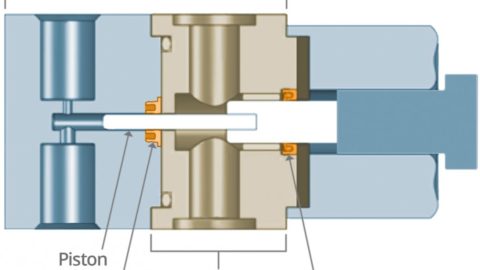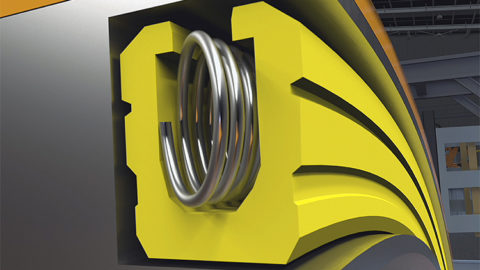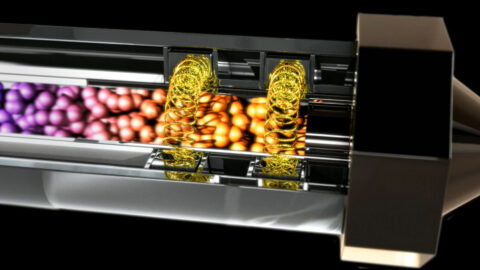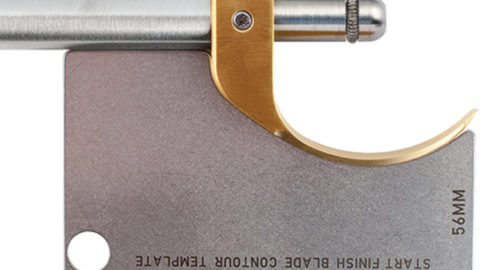When engineers develop orthopedic surgical devices, they must often think beyond the design of the device, and find a way to make its installation easier, safer, and more accurate. Sometimes experimentation leads to an unusual solution: a tiny, canted coil spring.
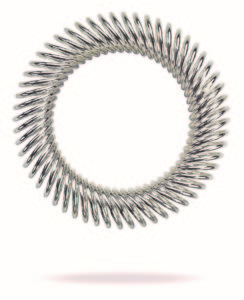
For example, one orthopedic company was developing a femoral nail to address a variety of femoral fractures, ipsilateral neck/shaft fractures, fixation of femurs that have been surgically prepared (osteotomy) for correction of deformity, and more in both children and adults. Because the device could be used in children as young as seven or eight years old, it needed to be minimally invasive and minimize damage to growth plates.
As with any nailing system, one of the challenges for product engineers was not the nail itself but the precise positioning of the locking screws. The targeting screws must be precisely positioned. To do that, the surgeon’s drill must be guided directly to the intended location.
Guiding and Positioning Drills in Surgery
Orthopedic surgeons rely on specially designed guide hardware to properly pre-drill holes prior to tapping and fixation of implants in surgeries requiring screws to fix bone and synthetic ligaments. Locking the nail is often the main complication in surgeries of this type. If the nail is not properly locked, it can move inside the bone — causing pain for the patient. In some cases, improper locking can cause the implant to fail prematurely.
Because of the smaller size of some patients and the increased possibility of complications from damage to growth plates, the accuracy of such a drill has tremendous implications on the procedure — even more so than in typical orthopedic surgeries. Understandably, there is generally a lower threshold for tolerating errors or pain when operating on children. In procedures involving femoral nails, the surgeon has to drill through soft tissue in order to fix the locking screws to the bone. For that reason, making drill and screw positioning more reliable is critical.
The Spring Solution
For the femoral nail system, for example, the engineers developed a targeting device to ensure proper positioning of the nail and the targeting screws. Once the nail is inserted into the femur at the appropriate depth, two guide tubes — an outer guide tube (4.5mm) and an inner guide tube (3.5mm) — are inserted into the targeting device and pushed down to the skin.
These tubes guide the surgeon’s drill to the intended location and are essential to the proper positioning of the locking screws. Holding the tubes in place during this most critical step in the procedure are two Bal Spring® canted coil springs, manufactured by Foothill Ranch, CA-based Bal Seal Engineering, Inc.
It is important that the inner and outer guide tubes are advanced to the lateral cortex of the femur. Failure to do so could have an effect on proximal screw measurement and insertion. The Bal Spring canted coil springs ensure that the tubes do not retract once they are advanced to the lateral cortex of the femur, enabling the surgeon’s drill to hit its intended target.
O-rings, snap rings, and ball detents are sometimes used in similar applications to guide and center drills in orthopedic procedures. While these components generally are an improvement over unassisted drill placement, their use can still result in imprecise positioning, requiring surgeons to use two hands to more accurately place their drill.
By contrast, the canted coil springs can be used for latching, locking, and holding applications. They are available in coiled diameters from 0.020 in. (0.51 mm), and in a variety of materials and surface finishes. In addition to fastening or latching, the canted coil spring can be designed to permanently lock two pieces together, or to perform a holding function whereby it provides a specific amount of drag between two components.
Other methods that might secure the sleeves together are not viable because they involve more complex components. The inclusion of two Bal Springs provides a simple solution to the challenge of preventing the guide tubes from sliding out of the targeting guide under their own weight.
Since the introduction of the femoral nail, the Bal Spring has provided the reliability necessary for drill positioning and targeting in surgery. The consistent forces applied by these springs allow surgeons to easily target and pre-drill holes without using two hands.
Designers of femoral implants aren’t alone in leveraging the benefits of the canted coil spring. In fact, the component has proven to be useful in the process of tibial trialing, as well. Knee replacement system engineers have incorporated the spring into specially-designed shims, or “trials” that allow for accurate sizing of the joint during the implant procedure.
The trials, made from a medical-grade polymer (often a Polyphenylsulfone such as Radel®), are temporarily placed into the orthopedic assembly, where they are securely latched in place by a tiny spring that provides the surgeon with feedback in the form a tactile “click.” Spring breakaway forces, which can be precisely determined and controlled by the device engineer, allow for easy removal of the trial once correct sizing is achieved.
Engineers at Spinal Simplicity, LLC incorporated the spring into their Minuteman G3 spinal fusion device (which was highlighted in the March 2017 issue of Medical Design Briefs). In this application, the spring temporarily latches a linearly traveling plunger used by the surgeon to deploy folded arms, which affix to the spinous processes on either side of the placement.
The versatile canted coil spring component has even found its way into the instruments surgeons use to perform orthopedic procedures. For example, Waltham, MA-based Life Instruments Co. has designed the springs into its radiolucent cervical retractor, which is used by surgeons to spread both the skin and muscles surrounding the spine in order to access and repair the vertebrae. In the tool, two springs, positioned inside grooves in the retractor blades, serve as snap-connector components while providing circular referencing “footprints” for guidance under x-ray.
Cleanability
Another design aspect that engineers need to consider when selecting device and tooling components for orthopedic devices is their ability to withstand repeated cleaning and sterilization processes. According to an independent test report, the Bal Springs are cleanable and reusable, meeting medical device industry standards as well as Food and Drug Administration (FDA) regulations.
The FDA has noted that inadequate reprocessing of medical devices can result in the retention of biological debris or soil in certain types of reusable medical devices, allowing microbes to survive the disinfection or sterilization process. Earlier this year, Bal Seal Engineering released the results of a third-party test, conducted under worst-case conditions, which validated that a device containing a canted coil spring can be properly cleaned by either manual or automated cleaning methods. (“Cleaning Evaluation R&D Report,” test report for Bal Seal Engineering, Nelson Laboratories, 12 May 2017.) The springs can withstand stringent cleaning methods – from manual scrubbing to automated dishwasher systems.
Following use in a surgical procedure, the springs used in orthopedic devices and tools should be carefully removed and thoroughly cleaned. Many surgeons are surprised to discover that the springs meet cleanability requirements — possibly because alternative solutions like O-rings and snap rings have proven difficult to clean and sterilize, making them less desirable for use in re-usable surgical instruments like the femoral nail targeting guide.
Conclusion
Thanks in part to the use of Bal Spring® canted coil springs, orthopedic device manufacturers can develop systems that allow surgeons to accurately position drills for orthopedic surgeries in children and adults. By using canted coil springs in orthopedic targeting guides, for example, surgeons can help reduce post-operative pain and implant failure by more accurately drilling for locking screws, which are critical for the success of surgeries treating femoral fractures and deformities. Additionally, the inclusion of the springs allows targeting guides and other devices to meet cleanability requirements, making them reusable when cleaned according to the manufacturer’s recommendations.
This article was written by David Wang, Global Market Manager of Medical Devices for Bal Seal Engineering, Inc., Foothill Ranch, CA. For more information about Bal Seal Engineering, Inc. or the Bal Spring® canted coil spring, visit www.balseal.com/springs, or e-mail dwang@balseal.com.

